elemintalshop
Veragua Stubfoot Toad & Revolutionary Martyr Jose Felix Ribas 5 Bolívares Venezuela Authentic Banknote Money for Collage (Harlequin Frog)
Veragua Stubfoot Toad & Revolutionary Martyr Jose Felix Ribas 5 Bolívares Venezuela Authentic Banknote Money for Collage (Harlequin Frog)
Couldn't load pickup availability
Veragua Stubfoot Toad & Revolutionary Martyr Jose Felix Ribas 5 Bolívares Venezuela Authentic Banknote Money for Jewelry and Collage (Henri Pittier National Park) (Harlequin Frog)
Reverse: Veragua Stubfoot Toad (Atelopus Cruciger), called "Sapito Rayado" and "Rancho Grande harlequin frog". Background is a view of Valles de Aragua in Henri Pittlier National Park.
Coat of arms of Venezuala left.
Lettering: Banco Central de Venezuela
Cinco Bolivares
Sapito Rayado
Parque National Henri Pittier-Valles de Aragua
Obverse: Jose Felix Ribas ( 1775-1845), hero martyr of Venezualan independence war at bottom. Background of stripes, flowers and map.
Lettering: Republica Bolivariana de Venezuela
Cinco Bolivares
15 DE ENERO DE 2018
PAGADEROS AL PORTADOR
EN LAS OFICINAS DEL BANCO
Translation: Bolivarian Republic of Venezuela
Five Bolivares
15 January 2018
Payable to bearer In the offices of the bank
Front back registration images left of a star and a toad.
Watermark: Portrait of Simon Bolivar
Features
Issuer Venezuela
Issuing bank Central Bank of Venezuela
Period Bolivarian Republic (1999-date)
Type Standard banknote
Year 2018
Value 5 Bolívares
5 VES = USD 0.0000010
Currency Bolivar Soberano (2018-2021)
Composition Paper
Size 69 × 156 mm
Shape Rectangular
Number N# 208164
References P# 102
Wikipedia:
Atelopus cruciger, also known as the Veragua stubfoot toad or Rancho Grande harlequin frog, is a species of toad in the family Bufonidae. It is endemic to Venezuela and is known from the central Venezuelan Coastal Range. The species was already suspected to be extinct because, despite considerable effort, none had been found since 1986. However, in 2003, a small population was found, with few other locations discovered later.[4] It is mainly threatened by chytridiomycosis [fungal disease]. It is locally called sapito rayado.
*******
Wikipedia:
José Félix Ribas, 19 September 1775 – Tucupido, 31 January 1815) was a Venezuelan independence leader and hero of the Venezuelan War of Independence.
Early life
Ribas was the last of eleven sons, born to a prominent Caracas family. In his early years, he received a quality education and attended the city's seminary. After finishing his studies, he began working in the agrarian sector. At the age of 21 he married María Josefa Palacios, the aunt of Simón Bolívar. He soon became interested in Republican ideals and sympathetic to the revolutionary independence movement.
Ribas became involved in the Conspiracy of 1808, but was taken prisoner after its failure. In his defense, he stated that on the day of the action, he was just heading to a public square to spend time. Actually, Ribas was frequenting the square to meet with other republicans to plan an uprising. He was later freed by the authorities.
When the Revolution of 19 April 1810 was taking place, it was reported that Ribas was seen travelling throughout the entire city, encouraging people to join-in the demonstrations against Spanish rule. In the aftermath he joined the interim government on April 25, taking charge of the municipality of Caracas.
Military career
Apart from his political functions in the interim government, and despite having no military background, Ribas was named Colonel of the Barlovento Battalion which he helped set up with his own funds. He also maintained some contact with Francisco de Miranda, and offered him all possible support when Miranda arrived in the country. Along with other fellow Republicans, he became a member of the Sociedad Patriótica organized by Francisco de Miranda, in contradistinction to the New Venezuelan Congress which was ruled mostly by the landed few. The Sociedad Patriótica was modeled after a French Jacobin Club, encouraging the practice of oratory on equality of rights to all citizens.
During a brief period of Venezuelan independence (the Second Republic of Venezuela under the stewardship of Simón Bolívar), Ribas fought in numerous battles of the "Campaña Admirable"; however the most crucial episode was the battle of La Victoria (12 February 1814) in which he and his comrades succeeded in foiling the advance of José Tomás Boves's formidable royalist forces (commanded in this battle by proxy Francisco Tomás Morales, while Boves recovered from wounds). Ribas won this victory with inexperienced troops, composed mainly of youths, students, and seminary candidates that Ribas has succeeded in recruiting. Ribas told his young soldiers, his charges, before a crucial battle that "We have no choice between victory or death, we must achieve victory" ("No podemos optar entre vencer o morir, es necesario vencer"). After many hours of fierce resistance, Republican reinforcements arrived under the command of Vicente Campo Elías. It is in honor of this episode of Venezuelan history that modern Venezuelan citizens now celebrate the "Día de la Juventud" ("Day of Youth"). each 12 February.
Capture and death after Urica and Maturín
He fought vigorously in the Battle of Urica in which the republican forces lost but his royalist nemesis Boves was killed. After this battle, his forces assisted in offering a last desperate resistance to Morales at the Battle of Maturín; however this effort also was defeated. Ribas, together with a nephew and a faithful servant, was forced to flee from the victorious royalists. However, he was ultimately betrayed to the royalists by a slave. He was captured and executed by beheading. Ribas's lopped off head, after having been fried in cooking oil, was sent to Caracas. There, it was placed in public display within a small cage with the intention of demoralizing the patriots.
Legacy
Almost two centuries later, Ribas' deeds were commemorated by the Hugo Chávez government when it named one of the Bolivarian Missions "Missión Ribas" in his honor. There are also two Venezuelan municipalities named after him, José Félix Ribas Municipality, Aragua state; and José Félix Ribas Municipality, Guárico state.
******
Wikipedia:
Henri Pittier National Park is the oldest national park in Venezuela, originally created in 1937 under the name of Rancho Grande by decree of President Eleazar López Contreras. In 1953 the park was renamed in honor of Henri Pittier, a distinguished Swiss geographer, botanist and ethnologist, who arrived in Venezuela in 1917, classified more than 30,000 plants in the country and devoted many years studying the flora and fauna in the park.
Henry Pittier National Park has the honor of having started the history of national parks of Venezuela. Its 107,800 hectares, located in the north of Aragua state, comprise most of the Araguan coast and mountainous area of Carabobo state. It also borders San Esteban National Park. Henri Pittier National Park is the largest among the national parks of the Venezuelan Coastal Range.
The park consists of two geographic systems: a steep mountainous interior where there are more than 500 bird species and 22 endemic species and a coastal area with bays, beaches and resorts with huge tourism potential. There is a great diversity of flora and fauna. The park is an Important Bird Area.[1] and is an Alliance for Zero Extinction (AZE) site.
With its nine major rivers, the park is an important source of water for surrounding cities and towns. It also contains land where some of the best cacao in the world is cultivated, especially in the village of Chuao.
*********
WIkipedia:
Simón José Antonio de la Santísima Trinidad Bolívar y Ponte Palacios y Blanco, 24 July 1783 – 17 December 1830), also colloquially as El Libertador, or Liberator of America, was a Venezuelan military and political leader who led what are currently the countries of Colombia, Venezuela, Ecuador, Panama, Peru, and Bolivia to independence from the Spanish Empire.
Bolívar was born in Caracas into a wealthy family and, as was common for heirs of upper-class families in his day, was sent to be educated abroad at a young age, arriving in Spain when he was 16 and later moving to France. While in Europe he was introduced to the ideas of the Enlightenment, which later motivated him to overthrow the reigning Spanish in colonial South America. Taking advantage of the disorder in Spain prompted by the Peninsular War, Bolívar began his campaign for independence in 1808. The campaign for the independence of Colombia (Gran Colombia—later New Granada) was consolidated with the victory at the Battle of Boyacá on 7 August 1819. He established an organized national congress within three years. Despite a number of hindrances, including the arrival of an unprecedentedly large Spanish expeditionary force, the revolutionaries eventually prevailed, culminating in the victory at the Battle of Carabobo in 1821, which effectively made Venezuela an independent country.
Following this triumph over the Spanish monarchy, Bolívar participated in the foundation of the first union of independent nations in Latin America, Gran Colombia, of which he was president from 1819 to 1830. Through further military campaigns, he ousted Spanish rulers from Ecuador, Peru, and Bolivia, the last of which was named after him. He was simultaneously president of Gran Colombia (present-day Venezuela, Colombia, Panama and Ecuador), Peru, and Bolivia, but soon after, his second-in-command, Antonio José de Sucre, was appointed president of Bolivia. Bolívar aimed at a strong and united Spanish America able to cope not only with the threats emanating from Spain and the European Holy Alliance but also with the emerging power of the United States. At the peak of his power, Bolívar ruled over a vast territory from the Argentine border to the Caribbean Sea.
Bolívar is viewed as a national icon in much of modern South America, and is considered one of the great heroes of the Hispanic independence movements of the early 19th century, along with José de San Martín, Francisco de Miranda and others. Towards the end of his life, Bolívar despaired of the situation in his native region, with the famous quote "all who served the revolution have plowed the sea". In an address to the Constituent Congress of the Republic of Colombia, Bolívar stated "Fellow citizens! I blush to say this: Independence is the only benefit we have acquired, to the detriment of all the rest."
*********
Wikipedia:
The current coat of arms of Venezuela was primarily approved by the Congress on April 18, 1836, undergoing small modifications through history, reaching the present version.
The coat of arms was established in the Law of the National Flag, Shield and Anthem (Ley de Bandera, Escudo e Himno Nacionales), passed on February 17, 1954, by the military governor of Venezuela, Marcos Pérez Jiménez. The shield is divided in the colors of the national flag. In the dexter chief, on a red field, wheat represents the union of the 20 states of the Republic existing at the time and the wealth of the nation. In sinister chief, on a yellow field, weapons (a sword, a sabre and three lances) and two national flags are tied by a branch of laurel, as a symbol of triumph in war. In base, on a deep blue field, a wild white horse (representing Simón Bolívar's white horse Palomo) runs free, an emblem of independence and freedom.
Above the shield are two crossed cornucopias (horns of plenty), pouring out wealth. The shield is flanked by an olive branch and another of palm, both tied at the bottom of the coat with a large band that represents the national tricolour (yellow for the nation's wealth, blue for the ocean separating Venezuela from Spain, and red for the blood and courage of the people). The following captions appear in golden letters on the blue stripe:
19 de Abril de 1810 (April 19, 1810) 20 de Febrero de 1859 (February 20, 1859)
Independencia (Independence) Federación (Federation)
República Bolivariana de Venezuela (Bolivarian Republic of Venezuela)
Share
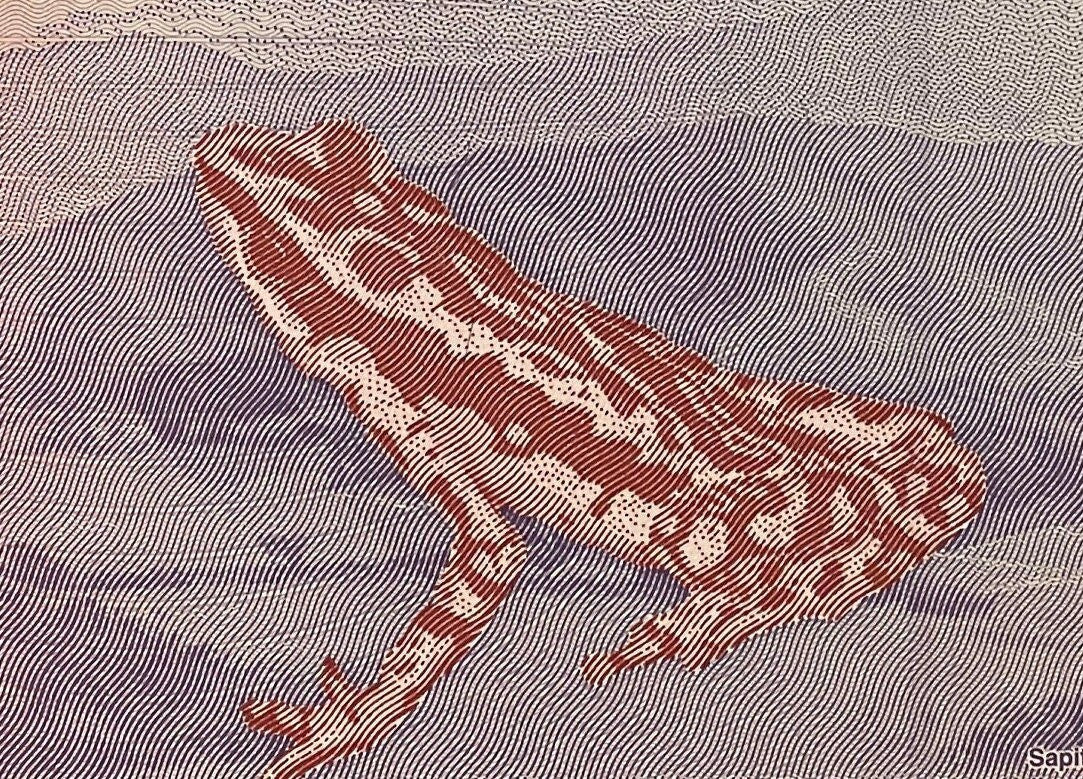
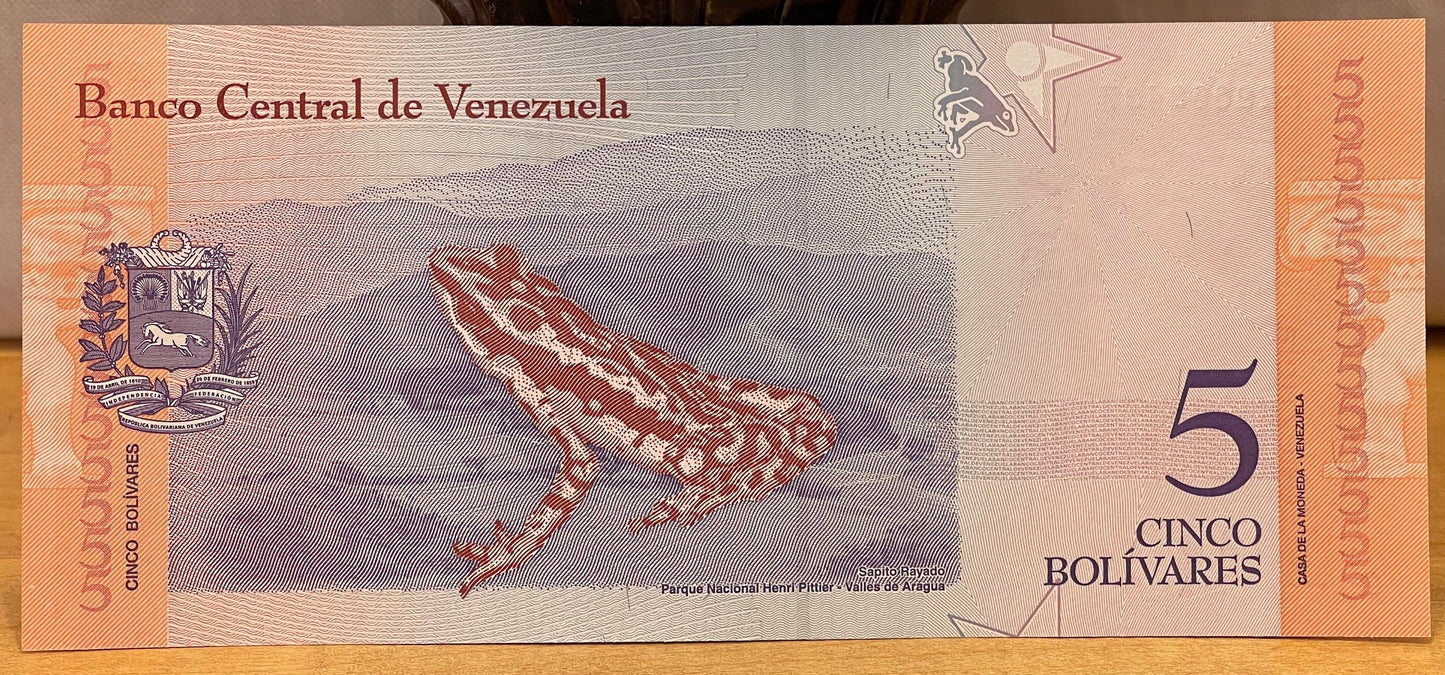
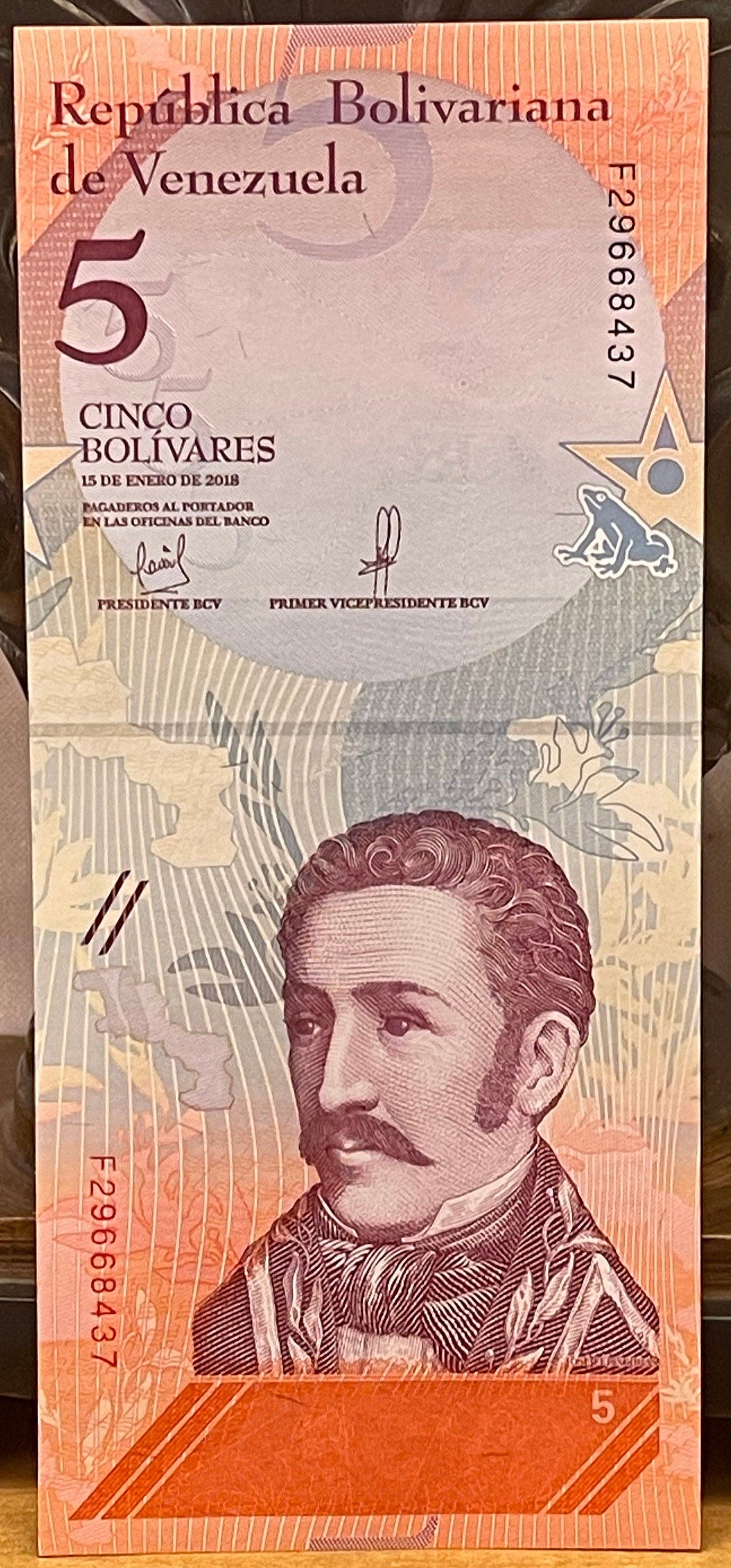
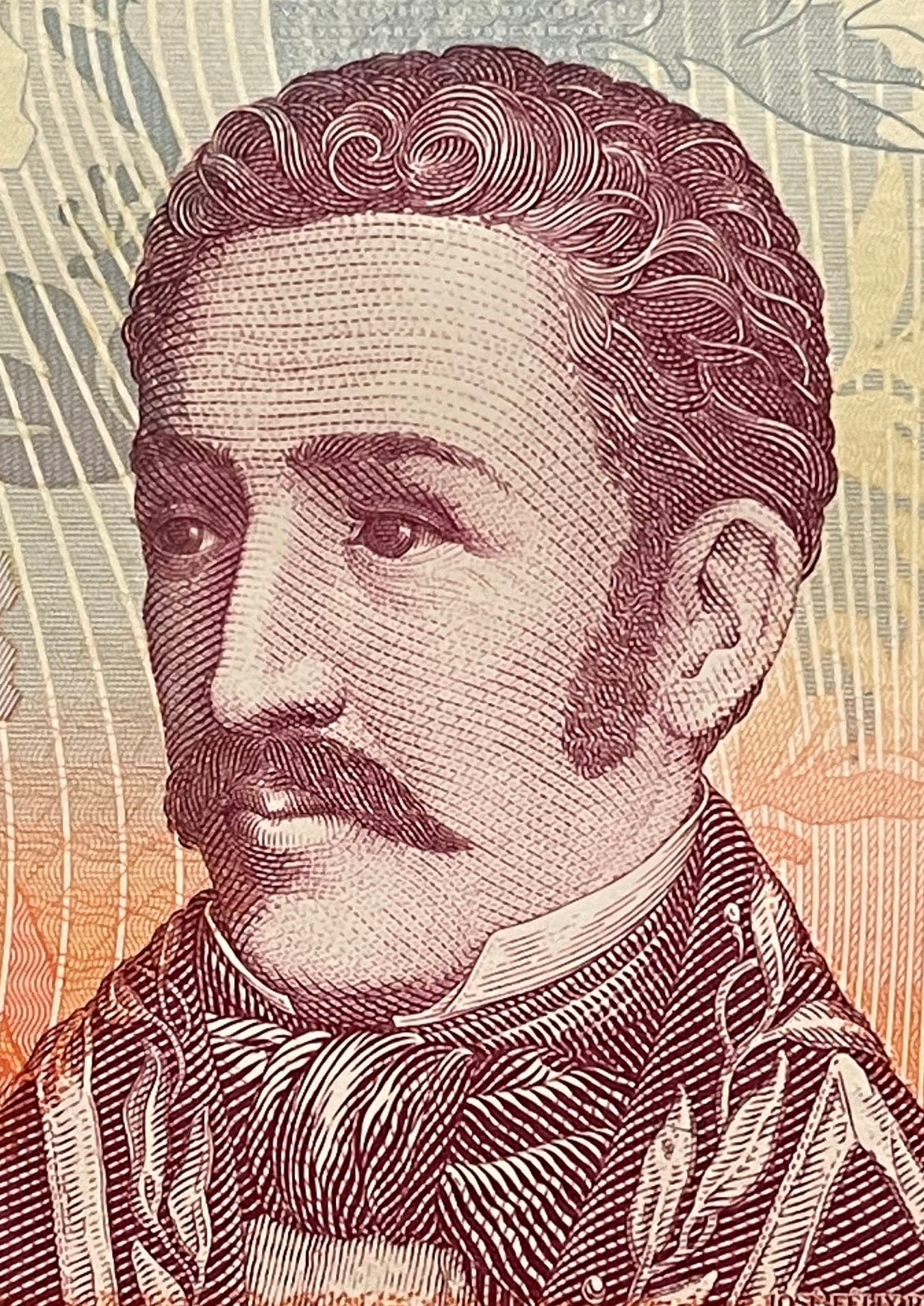
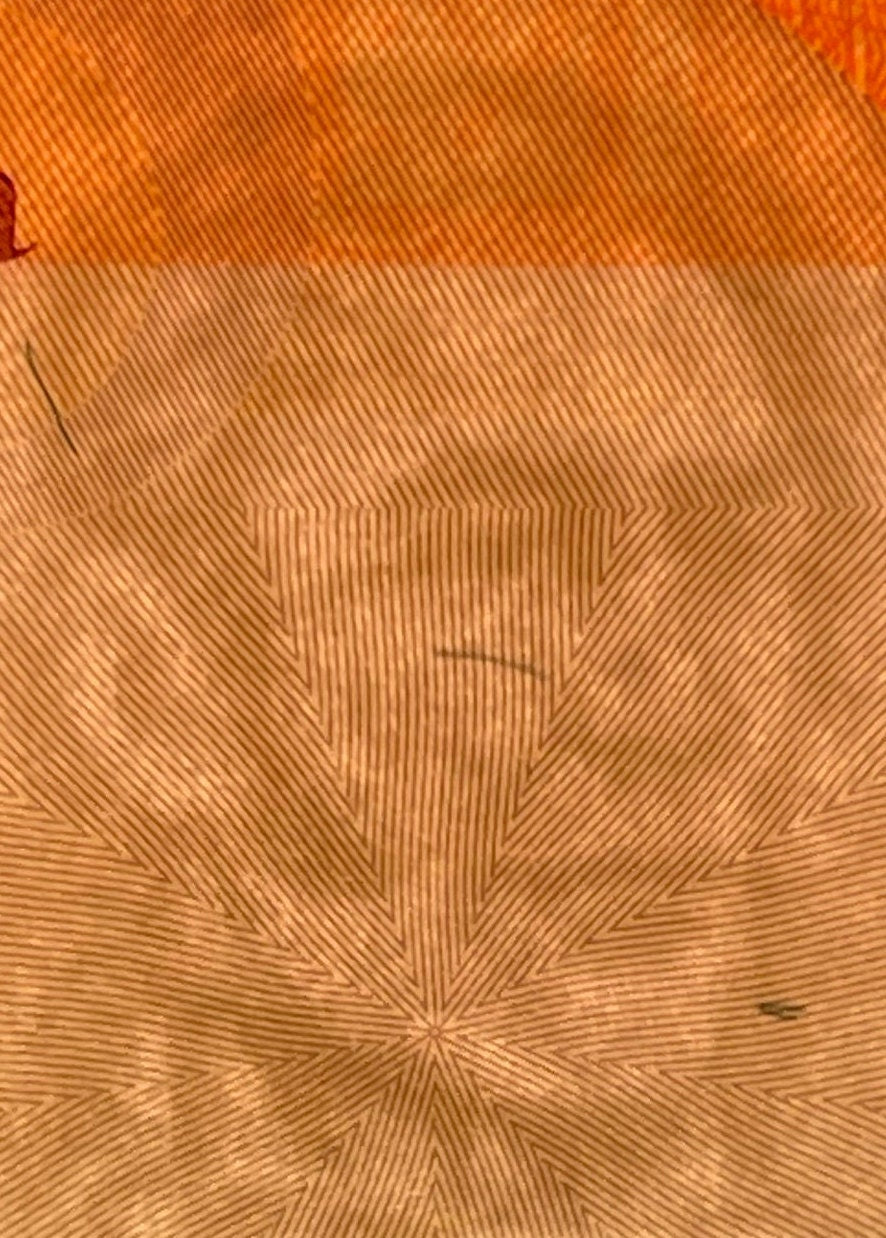
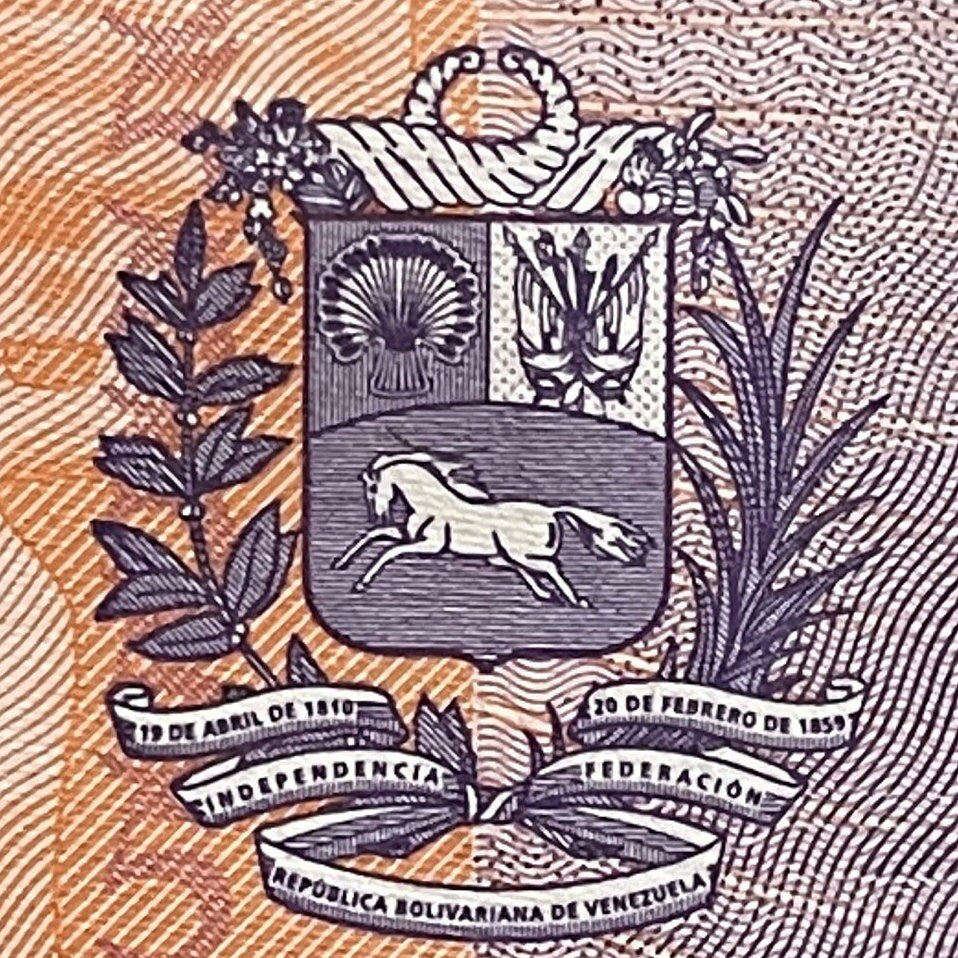
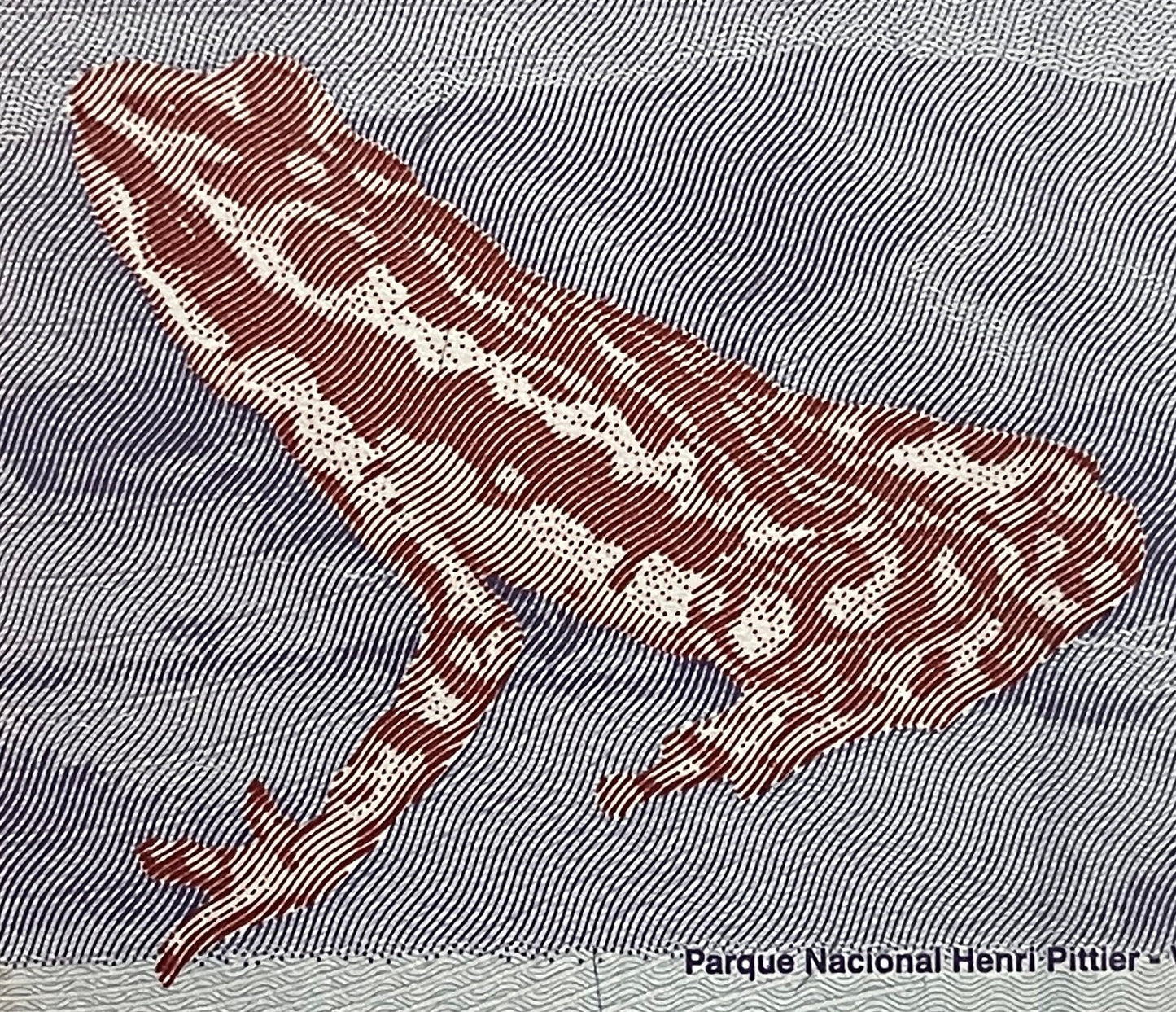
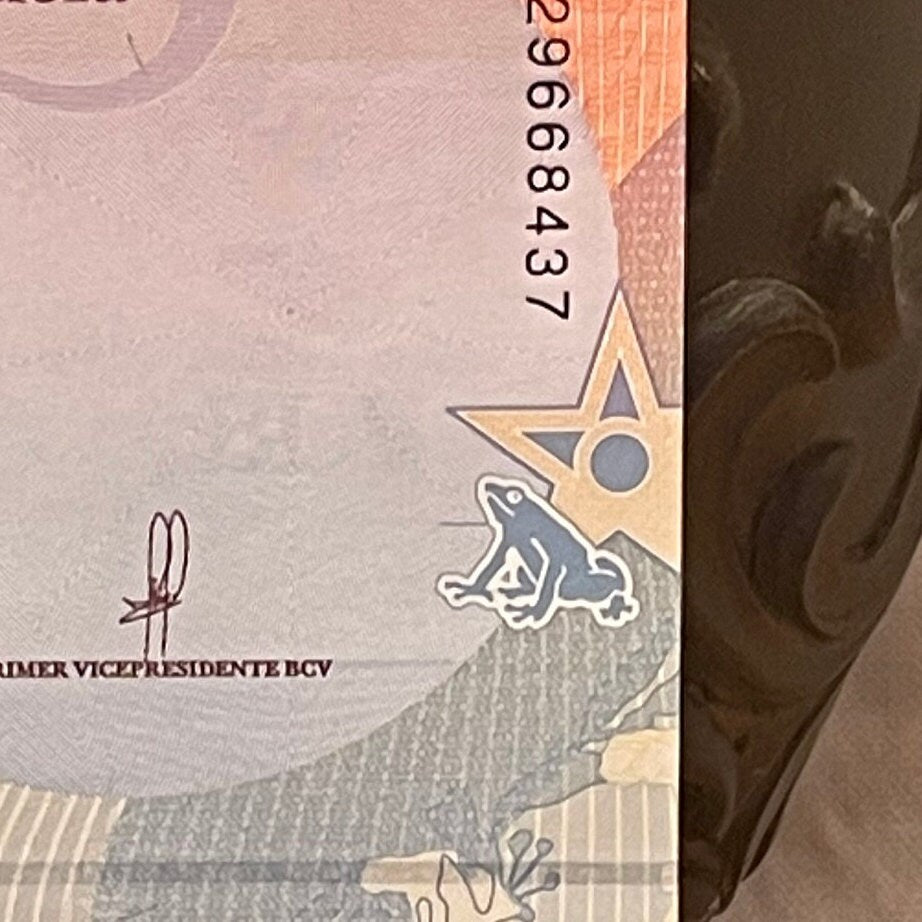
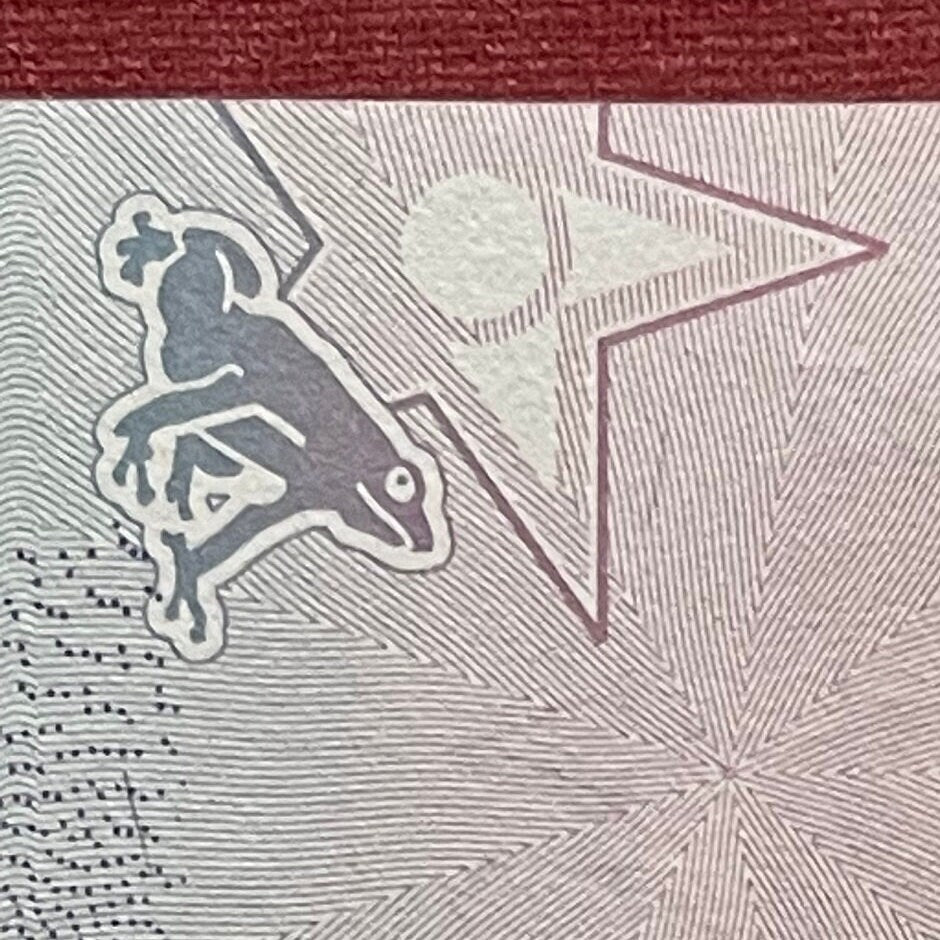

I highly recommend Elemintal for its wide variety of currency in perfect condition and in protective cases, for fast shipping and for low prices. Among many other great deals, I just received a Venezuelan 5 bolivares banknote. The Venezuelan bills of the 2000's are spectacularly beautiful. The obverses are 'portrait' formatted (that is, the top of the image is on the bill's left and the bottom on its right). Each has a portrait, and Jose Felix Riba, Venezuelan revolutionary martyr, appears here. The reverse is 'landscape', that is, the normal orientation of most banknotes. This bill features a harlequin frog!









